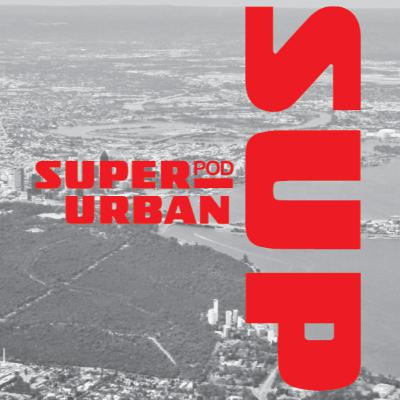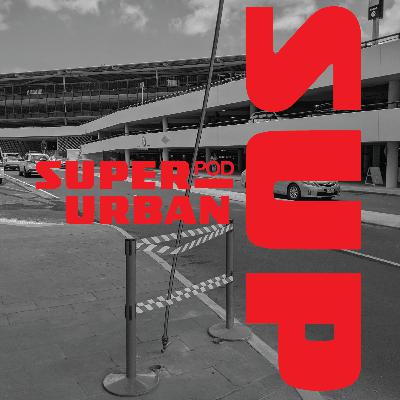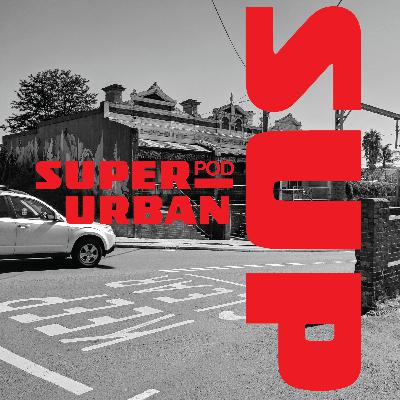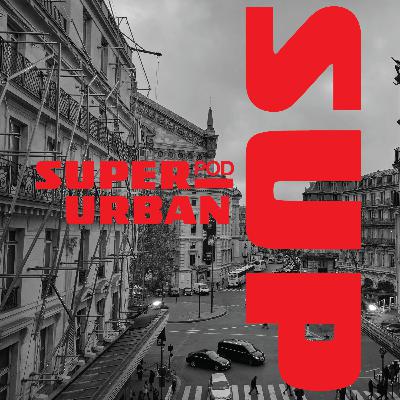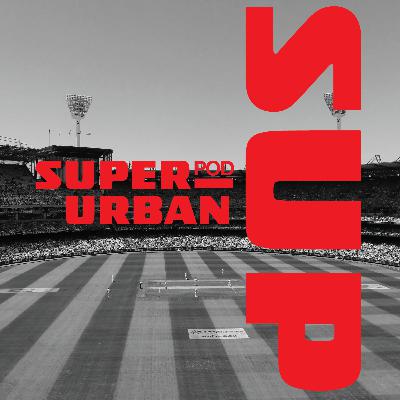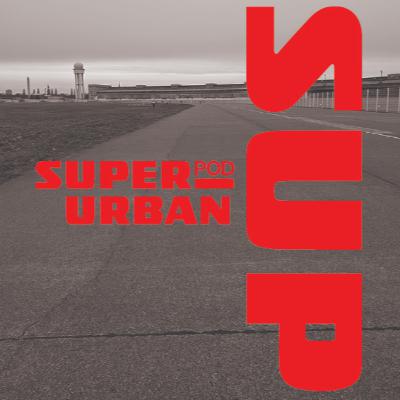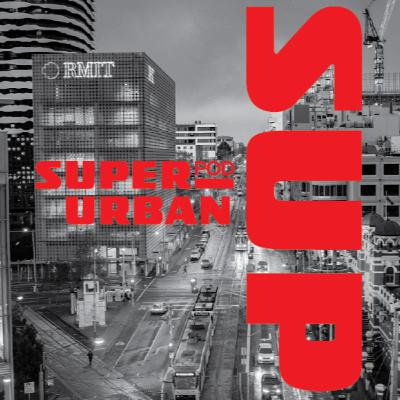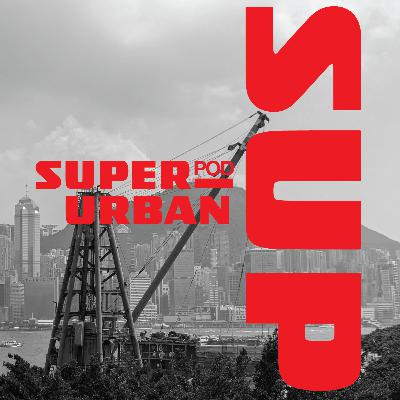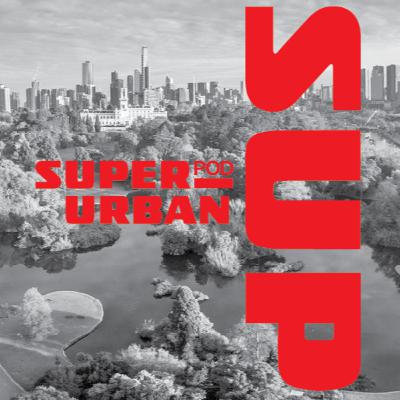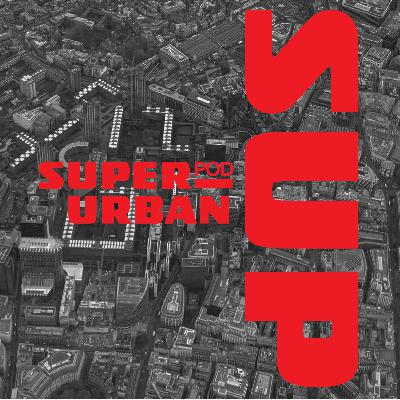Discover The Super Urban Podcast
The Super Urban Podcast

The Super Urban Podcast
Author: Super Urban Lab
Subscribed: 2Played: 33Subscribe
Share
© Super Urban Lab
Description
SUP – The Super Urban Podcast is a conversation about cities and how they’re designed; how we imagine them and how we could re-imagine them. Cities are the most complex things ever constructed and they are also our everyday, barely noticed environment. We’re here for a talk about cities from as many perspectives as possible. Each episode will focus on a specific theme, blending diverse viewpoints and engaging with broader contexts like history, economics, politics, and current social issues.
The Super Urban Podcast is hosted by Ian Nazareth, Graham Crist and Christine Phillips.
The Super Urban Podcast is hosted by Ian Nazareth, Graham Crist and Christine Phillips.
16 Episodes
Reverse
Ask a physicist, and they’ll tell you: the universe is mostly made of something we can’t see.Ordinary matter—everything tangible and visible—makes up less than 5% of reality.The rest? Dark matter.Unseen forces shaping galaxies, bending space, governing possibility.Now shift that lens to the city. What if the urban realm is also shaped by its own dark matter?Not cosmic, but economic, legal, institutional.Invisible forces that script the city before a single brick is laid.What happens when we try to make those forces visible?What if architecture wasn’t just about buildings, but about redesigning the systems beneath them?To face today’s challenges - extractive geopolitics, corporate colonialism, economic weaponisation - we may need to move beyond the object and think at the scale of infrastructures, institutions, and planetary systems.In this episode, we speak with Indy Johar—architect, systems thinker, and founder of Dark Matter Labs.A pioneer in reimagining the civic 'firmware' that underpins our lives, Indy works at the intersection of design, economics, and institutional reform.From co-founding Architecture00, to initiating open-source platforms like WikiHouse and OpenDesk, Indy’s practice pushes architecture beyond the physical, into the realm of civic and economic code.Together, we explore what it means to design new agents, new institutions, and new counter-infrastructures for a regenerative future.
Perth, the capital of Western Australia sites as the most geographically isolated capital city on earth, and sits on the time zone of two thirds of the worlds population. It one of the largest and least dense metropolises. Its bigger and smaller than it seems. Emma Jackson, our guest today is an architect and now tapestry designer. We studies together in Western Australia, and she has been our colleague at RMIT, where she carried out a series of projects under the title of the Strange- exploring the world of Western Australia’s mining town urbanism and vast landscapes. Her fascination with geology has brought her to design tapestries and textiles drawn from geological formation. As a once local and partial outside to Perth, there perhaps a particular view Emma takes to this city, through these lenses. We could talk about Perth’s relation to NASA, and the often heard claim that Perth was the first city to be seen from space. In Charles Waldheims intro to Richard Weller’s 2009 book Boomtown 2050: Scenarios for a Rapidly Growing City, he says: Perth first registered in international media in 1962 by turning on its lights to illuminate the south western coast of Australia for astronaut John Glen orbiting the earth in Friendship 7… Perth’s singularity and remoteness make it an unlikely indicator of tendencies and trends evident elsewhere. Perth is closer to the urban populations of Indonesia and Malayasia than to the Eastern Australian metropolises of Sydney and Melbourne. Even the city’s website describes Perth, with no small pride, as the most remote urban centre in the world. Perth named itself the City of Light after it turned it on for John Glen in 1962, and the connection to NASA continued when in 1979 the space station Skylab crash landed in western Australia east of Perth. It was a relief to NASA and many others that it ended its orbit in some of the least populated land on earth. There’s a similar narrative of isolation in Christos Tsolkios’ story titled Civil War from the 2014 collection Merciless Gods. In its opening the narrator says: Perth, all bland office buildings and vast suburban stretches, is a modern city at the edge of the world. It is an automated, clean city. The railway stations don't have toilets in them, as though it wasn't a city for human use… for the daily animal cycle of eating, drinking, shitting, pissing and sleeping. People there are proud of their trains. …the landscape makes a mockery of their attempts to control and master the environment. Even in the middle of the business district, in the dead centre of the city's heart, the ancient sand seeps through every crack. With every strong gust of wind the sand rises and swirls and dusts the concrete and plastic with a faint orange tinge. The sand is not the only ancient element which taunts and threatens the city…this white city lives in fear of the shadows cast by its black inhabitants. It was a thin young man with beautiful dark eyes who taught me that the sand is one of the weapons the landscape uses to fight back against the arrogance of the city. The unfathomable sky is another. Dwarfed by the sky and breathing in sand, Perth feels like a make-believe city. I kept meeting people who told me how in a few years it would be one of Australia's great cities. A few even suggested that one day it might be one of the world's great cities. But when I got to Perth I had no time for claims of a grand future. I was not impressed by the swiftness of the electric trains and the efficiency of the state-of-the-art communications systems. Instead I loved hearing him talk about the soil eating away at this baby metropolis. By the time I'd arrived in Perth I had stopped believing in cities.
In this episode, we explore the idea of Cities as Multiples and Endless Cities, a concept that challenges the traditional view of cities as singular, static entities. Instead, we’ll be discussing how cities are intricate, layered, and dynamic spaces, shaped by a multitude of influences—historical, cultural, architectural, and social. From the blending of ancient and modern design principles to the creation of diverse urban experiences that reflect the multiplicity of human life, cities are more than just physical spaces—they’re ecosystems of overlapping histories, identities, and possibilities. We’ll be drawing on the ideas of visionary architects and urban theorists like Romaldo Giurgola, Gordon Cullen, and Leon Krier, who have reimagined cities as complex, pluralistic environments. We’ll also look at how this pluralism manifests in real-world examples, from the playful eccentricity of Melbourne’s RMIT Building 8 to the integration of historical forms into contemporary urban fabrics. So, whether you're an architect, urban enthusiast, or just curious about the future of our cities, join us as we explore how cities, as multiples, continue to evolve and shape our world.
Conrad Hamann’s discussion of divided and fragmented cities describes stressed and dystopic places- urban environments that have become irreconcilable through ideologies, difference of religion, or of ethnicity. That discussion is highly charged with terms like ghetto, apartheid or redlining. It is an urban image drawn with walls and barbed wire fences but also with invisible virtual or administrative borders. Names like Berlin, Belfast, Soweto, Harlem, Jim Crow or Gaza all invoke powerful images of conflict and separation in cities. This is contrasted with cities separated from their outside and by protective walls- or twin cities united (Budapest or Minneapolis St Paul) and the tendency of a metropolis to absorb and join up villages ( London and Tokyo as great examples). We need to remember too that our conversation is happening on a city grid built on the unceded ground of a displaced population. Australian cities had formal apartheid systems (for example Perth’s CBD aboriginal exclusion zone until 1954 and ‘Boundary Streets’ that separated Indigenous Australians from non-Indigenous Australians). Hamann talks too about both vertical and horizontal urban divisions- the stratification in the section of a tower (a literal underclass through height separation) but also the horizontal fragmentation that can be induced by urban infrastructure like freeways. What is often remarkable is the ability of a city’s people to ignore- (or to be consciously blind) to an extreme division. The borders are often invisible.
The fourth episode Cities as Arenas for Social Change will explore the connection between urban design, social transformation, and political ideologies, drawing from historical examples to understand how cities have been reshaped to reflect and influence the societies that inhabit them. Cities and built environments aren’t just backdrops for daily life; they’re battlegrounds for ideas, power, and progress. For social transformation, from utopian experiments to authoritarian spectacles, from radical housing models to grand infrastructure projects meant to shape human behaviour. From the grand utopian visions of Garden Cities to the authoritarian spectacle of Nazi Berlin, urban planning has long been a tool for social transformation. We’ll explore radical plans like Le Corbusier’s "machines for living," Soviet Moscow’s collectivist cityscapes, and the sprawling baroque metro stations of Stalinist Russia—all designed to shape how people live, move, and think. But these lessons don't just belong to the past. As cities today continue to evolve under pressures like climate change, inequality, and technological advancement, the question of how urban spaces can foster social change is more relevant than ever. In this episode, we'll connect these historical precedents to the contemporary conditions in cities, examining how today’s urban planners and architects are grappling with similar questions: How can cities be designed to create more equitable, sustainable, and inclusive societies? Stay tuned as we unpack how the legacy of these past urban visions still echoes in today’s cities—and how they can help us navigate the challenges of the future.
Cities are theatres. In this third episode we think of cities as the setting or backdrop to drama and events – ideas connected to Berthold Brecht’s development of Epic Theatre in the 1920’s or of Henri Lefebvre’s focus on everyday urban life . Designers of cities have been consciously creating the elements of theatrical urban life through history. Edmond and Corrigan explicitly worked with this theatrical reading of architecture and urbanism, and understood the relationship between architecture and stage design. Conrad Hamann has talked about how quickly cinema took on the task of depicting cities and treated a city as a main character. We can think of Man with a Movie Camera by Dziga Vertov in 1929 and countless other films following. Conrad has talked too about the theatrical elements which have persisted in city design – the composed street; the city logo or icon; campus groupings, and triumphal arches. Each of these as venues for the Instant Theatre of life. 21st century cities are probably seen in google earth by more people that any other place, and even seeing cities from the air for the first time transformed the scale of urban drama. Yet the little theatrical moment of the encounter on a street corner persists. What does a theatrical reading of cities mean for us today?
SUP – The Super Urban Podcast – is hosted by Ian Nazareth, Graham Crist and Christine Phillips. In this second episode of the Super Urban Podcast, we dissect another fundamental layer of urban development: Cities as Industry. If cities were once defined by ideological and religious order, industrial modernity reconfigured them into factories of progress and production, landscapes of extraction and acceleration. Industry was not merely an economic function; it was a defining urban idea, and a remapping of power. Smoke billowing from factories was once a sign of economic vitality and civic virtue. With industry came stratification, pollution, and the entanglement between economic advancement and environmental degradation. What happens when the engines of prosperity become the mechanisms of decline and collapse? Have we arrived at the end of industry, or merely its mutation? This episode traverses the industrial city’s evolution—where railways were once the connective tissue of empires, birthing towns and economies in their wake, and later, the automobile fractured urban coherence, ushering in sprawl, highways, and logistical spines that would redefine mobility and access. Now, in the era of digital economies and dematerialized labour, are cities still industrial, or have they become pure software—factories of data, energy, and capital? If industry no longer requires proximity, what holds the city together? If industrial cities were designed to process goods and people, what do they process now? Information? Influence? Exhaust? Have we substituted one form of extraction for another, replacing coal with data, production lines with algorithmic efficiencies? Is the city itself the industry—an infrastructure of endless optimization, a logistical playground, a warehouse of desires? This podcast is made possible by the generous support of the Alastair Swayn Foundation and the RMIT University School of Architecture & Urban Design.The podcast is part of the Super Urban Lab at RMIT’s School of Architecture & Urban Design. We acknowledge the people of the Woi wurrung and Boon wurrung language groups on whose unceded Country we are recording this podcast.
SUP – The Super Urban Podcast – is hosted by Ian Nazareth, Graham Crist and Christine Phillips.In this episode Cities as Order, we speak to Conrad Hamann as we discuss contemporary perspectives on the emulated city, questioning its role as a symbol of order and an instrument of control.Conrad Hamann explores the impulse to emulate cities as a means of establishing order, authority, stability, and clarity. The enduring presence of Rome and Athens in urban design serves as a prime example, but we also see this in 19th-century Melbourne’s fascination with Venice. These forms of emulation are often colonial,where rapidly growing settlements borrow familiar urban forms to create an instant sense of structure and legitimacy—mirroring the mother country.This pattern extends beyond architecture into cinema, from the archetypal Wild West town to Fritz Lang’s Metropolis, where urban forms reinforce control, hierarchy, and power. The desire for order is closely tied to protection, conquest, and the assertion of ownership over land. This may also explain the obsession withcreating city icons—perhaps nowhere more apparent than in Melbourne—where a single building is expected to embody the identity of an entire city.This podcast is made possible by the generous support of the Alastair Swayn Foundation and the RMIT University School of Architecture & Urban Design.The podcast is part of the Super Urban Lab at RMIT’s School of Architecture & Urban Design. We acknowledge the people of the Woi wurrung and Boon wurrung language groups on whose unceded Country we are recording this podcast.
Welcome to SUP – The Super Urban Podcast – a discussion on cities from RMIT Architecture & Urban Design, in Narrm, Melbourne, Australia. Hosted by Ian Nazareth, Graham Crist and Christine Phillips.We would firstly like to acknowledge the people of the Woi wurrung and Boon wurrung language groups on whose unceded Country we are recording this podcast and extend that acknowledgment to all First Peoples ofAustralia who have been caring for the many layers of Country for over 60,000 years. This podcast is focused on cities, and while it is difficult to read the layers of Country within these built-up environments, we acknowledge that Urban Country requires the most attention in foregrounding the dynamic living cultures of Australia’s First Peoples. The Super Urban Podcast is a conversation about cities and how they’re designed; how we imagine them and how we could re-imagine them. Cities are the most complex things ever constructed and they are also our everyday, barely noticed environment. We’re here for a talk about cities from as many perspectives as possible. Each episode will focus on a specific theme, blending diverse viewpoints and engaging with broader contexts like history, economics, politics, and current social issues. Perspectives of Australia's First Peoples, responsible practice, post-carbon futures, circularity, urban infrastructure and affordability are all up for discussion.We’ll discuss what makes cities work, but we’re also interested in what makes us dream about cites, why we love them and how they exist in our imagination. This podcast is made possible by the generous support of the Alastair Swayn Foundation and the RMIT University School of Architecture & Urban Design.The podcast is part of the Super Urban Lab at RMIT’s School of Architecture & Urban Design.
In this episode of the Super Urban Podcast, we focus on Adelaide. A city of clarity. Streets framed by gardens. Squares laid out with foresight. A river threading quietly through civic life. Unlike other Australian settlements born from convicts or ports, Adelaide was conceived as a civic experiment — a city designed to reflect ideals, not just occupation. Colonel William Light imagined a place that was orderly, hygienic, and morally structured, yet flexible enough to grow with its people. Families of Scots, Cornish, and German Lutherans brought non-conformist values — a commitment to education, hard work, and collaborative progress — embedding these ideals into the city’s very fabric.
In this episode of the Super Urban Podcast, we focus on Sydney— the metropolis on the edge of the Pacific. When we mention Sydney, we can’t escape the picturesque: the glint of the harbour, or of the coast, Potts Point, Surry hills or Elizabeth Bay - Utzon’s spellbinding Opera House crowning the foreshore like a sculpture of civic ambition, or harry Seidler’s – Australia square and MLC centre. And now even Barangaroo. But beneath this lineage is perhaps a city of stark contradictions—dense yet dispersed, prosperous yet precarious, planned yet chaotic. From colonial foundations to climate pressures, from housing and affordability crises to cultural tensions, we ask—what kind of city is Sydney really? And more importantly, what kind of city does it want to become?
Hong Kong is a city drawn in section—stacked, stepped, suspended. A culture of building that has learned to fold terrain and threshold into one continuous surface. Architecture here is not a discrete object but a system of adjacencies—markets pressed beneath housing blocks, temples nested into retaining walls, gardens hovering above malls. It is a vertical choreography, where the street has been lifted, buried, replicated, and rerouted. Its history plays out as a sequence of layers, traces, and ruptured chronologies. A British colonial outpost and financial port city, its civic and spatial rituals persist through abrupt political and material shifts. Buildings change function without changing form. Materials wear thin but do not disappear. Cultural continuity emerges less from institutions than from improvised design intelligence—embedded in everyday acts of repair, adaptation, and repetition. The city’s compacted form stages a kind of cultural compression—where public and private are never fully resolved, and architecture becomes a medium for negotiating cohabitation, tension, and visibility. The threshold is always in flux: a shop spilling into a corridor, a shrine tucked behind a gate, laundry tracing territorial claims across a shared façade. Situated on the southern rim of the Pearl River Delta—one of the most intensely urbanised geographies on earth—Hong Kong remains an anomaly. Its design culture resists the smoothness of the region’s emerging megacities. It is textured, improvised, and deeply local, even as it performs on a global stage. A peculiar urban literacy thrives here: one born of constrained geographies and abundant cultural nuance. This same literacy is now under pressure from the slow erasure of civic space, the standardisation of planning codes, and the soft violence of homogenised aesthetics. Does its architecture risk losing cultural intelligence to the logic of compliance? And is there still a culture capable of inhabiting the slippages—between east and west, past and future, resistance and assimilation? In this episode, we explore how architecture can operate as cultural infrastructure—supporting fragile economies, public life, and creative expression. We do so through the lens of COLLECTIVE, a Hong Kong-based architectural studio deeply engaged with cultural and spatial systems across Asia and beyond. We’re thrilled to welcome Betty Ng to the Super Urban Podcast.
Saigon or Ho Chi Minh City is a metropolis of intense fascination for many of us. A city of close to 10 million which has experienced explosive growth in the 21st century after coming out of a turbulent 20th century. It was under French colonial occupation as Indo China until 1954 and of course reunited with North Vietnam in 1975, when it was almost instantly renamed Ho Chio Minh city. It is now a city with a famously intense street life, incredibly fine grained density and is an increasingly favoured international tourist destination, as well as an attractor of foreign business investment. It continues to undergo rapid transformation, with a new underground metro line, and plans for a new airport, new sea port and several more metro lines. The city was one of our main characters in the book Supertight (I did with John Doyle) were we were fascinated with the intimacy and looseness of its urban environment. We are joined today by two guests, HCMC locals who are currently in Melbourne- one residing, one visiting. Tu Truong is an architect and urban designer, trained at the University of Architecture in Ho Chi Minh City, and has spent time working at the Ho Chi Min City urban planning department. She is currently researching the wet markets of Vietnam in particular Saigon, and is visiting Australia for the first time as part of that research. Triet Le Is an architect and director of the Vietnam based practice 6A. He grew up in Saigon and did his architectural education in Oregon. He now resides in Melbourne while he carries out phD study and builds works in his home city. Triet has even worked as a delivery driver – an experience he has described as giving him a very extensive experience of the city.
As we walk around built-up cities of today, it’s easy to forget that nature laid the groundwork long before the first brick was laid. Ancient volcanic eruptions shaped the land and waterways we now build around. These deep-time forces still influence where we place our cities—and how they grow. And as cities grow, natural environments become increasingly altered, sometimes beyond recognition, but nature continues to exert a powerful influence on the shape and size of cities. In an era of climate crisis, we’re waking up to just how powerful that relationship still is. Today we’re diving into the deep history of Melbourne—also known as Naarm—with Dr Gary Presland, who quite literally wrote the book on the subject: The Place for a Village: How Nature Has Shaped the City of Melbourne. For those outside Australia, Melbourne/Naarm sits on the southeast coast and is Australia’s second-most populous city. But long before skyscrapers and laneways, this was Kulin Nation land—home to the Boon Wurrung and Woi Wurrung peoples, who cared for its rivers, grasslands, and volcanic plains for tens of thousands of years. The city as we know it was laid out in a grid beside the Birrarung—what many know as the Yarra River. Today, it’s easy to forget just how deeply nature has shaped this place—but that’s exactly what we’re here to explore. Dr Gary Presland is a non-Indigenous Melbourne/Naarm based writer and historian that studied history at La Trobe University and archaeology at the University of London. His major research interests have been in Aboriginal and natural history of the Melbourne area and Gary has written many terrific books including Aboriginal Melbourne: The lost land of the Kulin People, for God’s sake, send the trackers’, ‘The first peoples of Melbourne, Port Phillip and Central Victoria: The Eastern Kulin and not forgetting ‘The Place for a Village: how nature has shaped the city of Melbourne, just to name a few, which will be the main focus of our discussion today.
We’re living through a polycrisis - a moment where cascading ecological, technological, social, political and economic pressures are reshaping the world in the latency of the present. Complexity is not an anomaly of our time but its default setting. The challenge is not merely to decode it, but to engage with its temporalities, influence its exchanges, and anticipate reactions before they spiral beyond control. The future is not a thing you stumble into - but rather a continuous act. It is the unravelling of hacks – that are coded, crafted, and built in the friction of the present. Design practice in this realm holds urgency as its condition. The next lines of code… What we nurture, control, or push back against will determine continuity or collapse. We are interested in the agency of critical design practice – the tools, stories, and strategies we need to move from paralysis to possibility. How do we investigate the blind spots of our technologies, the narratives that shape them, and the speculative practices - architecture, fiction, design - that help us inhabit the present more consciously. This isn’t about imagining perfect futures or fearing catastrophic ones. It’s about a grounded optimism. This is a design problem to assemble radical frameworks and possibilities, even when the dominant narrative is collapse. Because to speculate today is not an escape. It’s a responsibility. To lead us through this domain - we are joined by Liam Young. Liam Young is an Australian architect and designer, a film maker, director and BAFTA nominated producer and visionary storyteller whose work explores the intersection of architecture, technology, and the future city. Operating between design, fiction, and critical foresight, he is the co-founder of the think tank Tomorrow’s Thoughts Today and the nomadic research studio Unknown Fields Division. His film work is grounded in academic research conducted at institutions such as Princeton, MIT, and Cambridge, and he now leads the groundbreaking Master’s program in Fiction and Entertainment at SCI-Arc in Los Angeles. He has authored and edited several books, including Machine Landscapes: Architectures of the Post-Anthropocene and Planet City, which imagines a speculative city designed to house the entire population of the Earth.
Welcome to SUP – The Super Urban Podcast – a discussion on cities from RMIT Architecture & Urban Design, in Narrm, Melbourne, Australia. Hosted by Ian Nazareth, Graham Crist and Christine Phillips.This podcast is made possible by the generous support of the Alastair Swayn Foundation and the RMIT University School of Architecture and Urban Design.Our first series, Urban Emulation, builds on a remarkable six-part urban history series delivered at RMIT University by Conrad Hamann, a legendary historian of Australian architecture and urbanism. Conrad is the author of Cities of Hope, a monograph on the work of Edmond and Corrigan in Melbourne.These episodes explore how cities are shaped over time through emulation —the act of copying and transplanting places elsewhere. We argue that urban processes inherently absorb emulation into their very code—whether through deliberate replication, subconscious borrowing, or systemic reproduction of spatial, economic, and cultural patterns.Each episode focuses on a key theme illustrating how these ideas have historically influenced urban spaces and continue to shape contemporary cities:- Cities as Order- Cities as Industry- Cities as Theatres- Cities as Arenas of Social Change- Cities as Fragmented and Divided- Endless and Multiple CitiesJoin us as we unpack these ideas and explore the ways cities evolve through imitation, adaptation, and transformation.The podcast is part of the Super Urban Lab at RMIT’s School of Architecture & Urban Design. We acknowledge the people of the Woi wurrung and Boon wurrung language groups on whose unceded Country we are recording this podcast.



